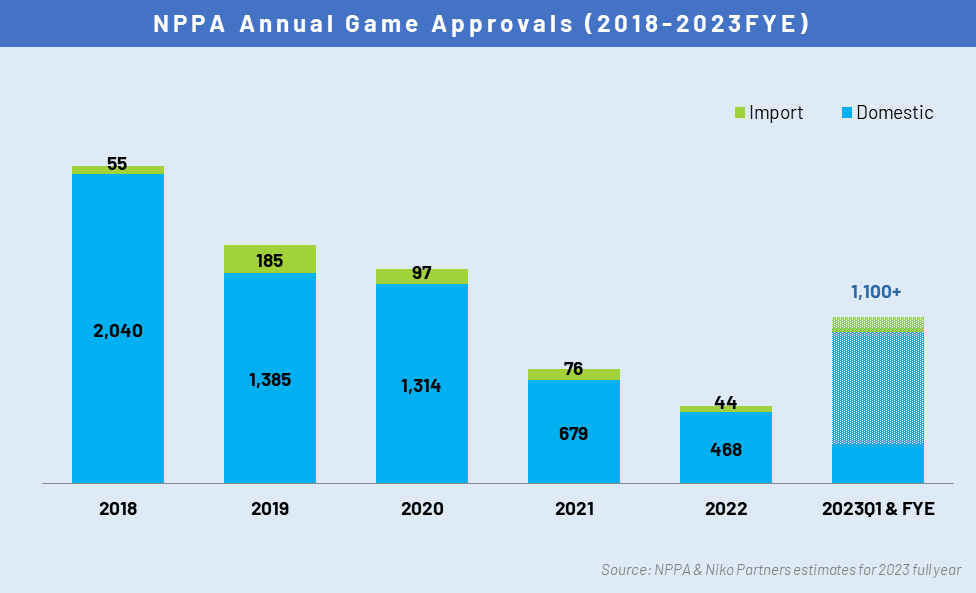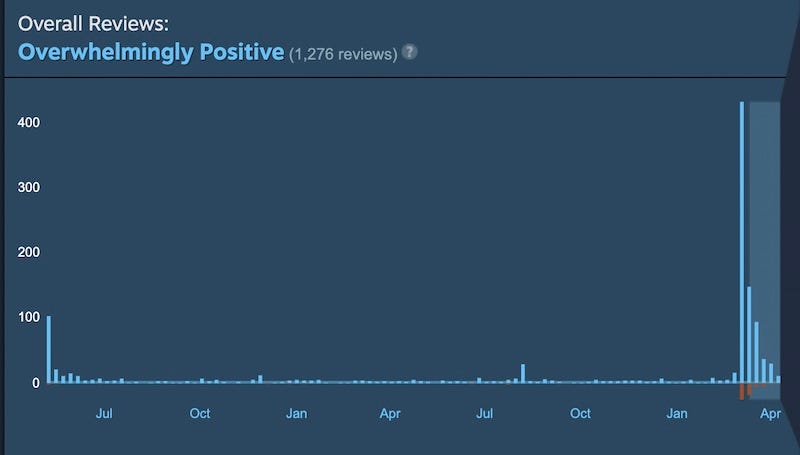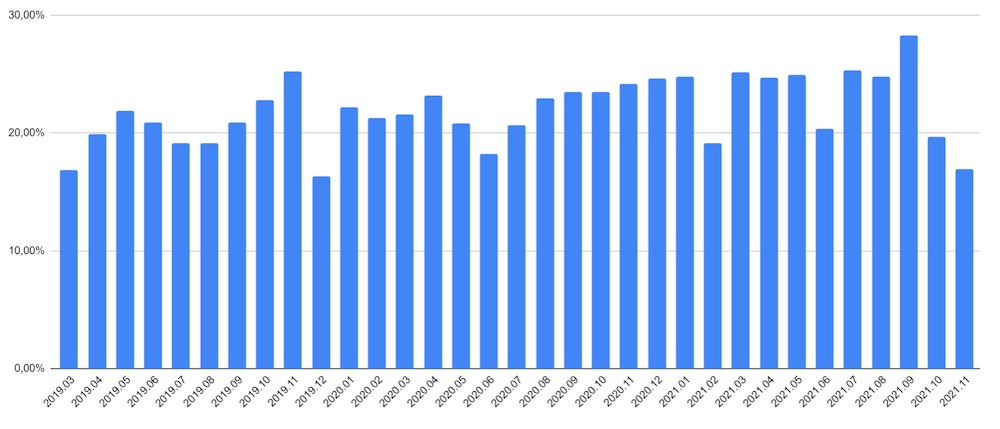Why games get big post-release discovery boosts
Publikováno: 10.4.2023
Some case studies. Also: Steam wishlist conversion & a giant heap of news.
[The GameDiscoverCo game discovery newsletter is written by ‘how people find your game’ expert & company founder Simon Carless, and is a regular look at how people discover and buy video games in the 2020s.]
Welcome to an early edition of GameDiscoverCo’s free Monday newsletter. Since we’re out of town this week, you’ll be getting a) this newsletter, b) no Wednesday edition, and then c) a Plus-exclusive game trends missive on Friday. And you’ll like it.
We’re presuming this doesn’t create a Matt Levine ‘Money Stuff’-style effect, where all kinds of massive breaking news hits ‘cos we say we’re taking a couple of days off. (Somebody tell the Saudis to delay their acquisition of Bubsy until we get back?)
[Don’t forget: our GameDiscoverCo Plus paid subscription includes our Friday ‘exclusive’ newsletter, exclusive Discord access, a login to our Steam ‘Hype’ & post-release game performance chart back-end, multiple eBooks & more. Support us & make this all possible…]
Case studies: why games surge in popularity later?
When a PC or console game hasn’t launched great, there’s always part of you that says ‘hold on, the market will discover it about… now!’ At which point you pre-emptively strap in for blast-off, before discovering that your game is still good, but its reach… isn’t.
We talked about elements of this recently with our (possibly overly pessimistic?) newsletter ‘Your Early Access launch? It (kinda!) is your launch...’ But what we didn’t talk about was why games sometimes re-ignite - at 1.0 or an arbitrary future point.
Among Us’ Victoria Tran just wrote something very helpful about this, correctly noting: “revitalising an old game’s visibility and sales is extremely difficult, so be smart about it”, and listing ways - from sales to huge updates to influencers - that might move the needle.
But let’s look at two very specific examples of games that recently did just that, and our impressions about why:
The Last Epoch: it’s all about the multiplayer, folks!

Pop quiz: when was online multiplayer/co-op added to Eleventh Hour’s already polished and successful Diablo-like ARPG The Last Epoch (above)? Could it have been… March 9th, 2023? Yes indeed, it was. And it took the game to a whole other level of success.
We’ve seen this happen time and again. For example, we talked to Project Zomboid about how their decade-old title blew up even bigger when multiplayer was added in December 2020 - it’s a pretty similar situation.
I think the reasons for this are obvious, but for clarity: a lot of people don’t like playing games solo, and want to play with their friends or relatives. Socialization using online co-op is the key to success for massive sandboxes like Fortnite & Roblox.
The other half of this is that YouTubers are very happy to take a fresh look at a game when big new features are added. Multiplayer is definitely one of those. And given that The Last Epoch has been around since April 2019 on Steam, and has been a bit of a ‘sleeper hit’ even before multiplayer, there’s a lot of new depth to re-examine there.
Patch Quest - 1.0 + influential streamer re-engagement?
It’s on a slightly different scale, but Lychee Game Labs’ and Curve’s ‘Pokemon + Metroidvania + roguelike’ mashup Patch Quest has had a very successful start to its 1.0 life on Steam, after an ‘alright’ May 2021 launch and a long Early Access period.
There wasn’t necessarily a big signature update, like multiplayer, which sent its interest over the top, although there were some changes and updates. Instead, I would say that the framing of the 1.0 release allowed re-pitching of the game to influencers.
And there are some particular influencers, like NorthernLion, who played the game on March 2nd, who influence other influencers (!) to give a game a chance. So we definitely see Patch Quest as ‘great - and getting greater - game that lacked reach until YouTubers gave it more’. The result:
Obviously, the game becoming 1.0 and appearing on Steam’s ‘New & Trending’ front page section also helped. But I do think that Twitch & particularly YouTube - even via a video made by its creator - was the chief reason for the impressive interest increase.
But since it’s streamer-caused, this kind of spike may dissipate quicker than engagement spikes caused by more permanent gameplay changes like online co-op. You can come back to play with your friends all the time, but YouTubers rarely play your game repeatedly for months…
Conclusion: many ways to skin cat, some easier..
So these are just two examples of what we all want if our launch wasn’t perfecto - the ‘interest spike’ that comes significantly after a game’s release. Ranking these from easiest to hardest:
Easier? Take your game 1.0, after improving it a lot: using these natural patch or 1.0 events to re-engage with the press - and especially influencers - can lead to shorter-lived, but still extremely grin-inducing discovery events, which should still affect the game’s ‘long tail’ positively.
Medium? Add a major new online multiplayer feature: for games that are already semi-successful, finding ways to add online multiplayer (especially co-op) can be a major, longer-term interest game changer. (Or just build that in to start.)
Hardest? Have your multiplayer game go extremely viral: the multiplayer-only space is brutal, and the whims of players are very hard to predict. But when games break out - especially in the ‘social deduction’ space, apparently - they can go mega-viral. (See: our profiles of Among Us, of Goose Goose Duck and of Dread Hunger.) We don’t know how you do this, though. But feel free to try!
Steam wishlist conversion by age - new(ish) data!
Eagle-eyed readers know that we recently linked to this great GIC talk by Pawel Lekki, discussing ‘marketing engineering’ for Steam hit ‘tower defense x basebuilder’ The Riftbreaker, which had 380k Steam wishlists at launch, and more than 500,000 copies sold in its first year.
Delving into the slide deck, which Pawel kindly sent us, we found a choice stat. You can see (above!) the % of Steam wishlists for The Riftbreaker converted to sales post-release, based on the month the wishlist got added.
He thinks that “old wishlists converted slightly less than newer ones” - which seems true, though the effect is very marginal. However, the visible conversion dips were for the Zombie Driver 10th anniversary promotion in December 2019, which had a prominent Steam sale/curator list, and Steam Next Fests in February and June 2021.
And indeed, conversion seems 20-30% lower for those months. This is great confirmation of something that Valve also provided data on a couple of years back. Quoting from our article then, which was about 2020’s Next Fest:
Median wishlist increase of 421%: 100 wishlists (normal); 521 wishlists (Next Fest)
Median wishlist conversion of 292%: 100 wishlists (normal); 392 wishlists (Next Fest)
Conversion rate comparison: 1x (normal); 0.752x (Next Fest)
So that’s two sources suggesting that the conversion percentage - at least in 2020 and 2021 - was around 25% less for wishlists picked up in a Next Fest. Not sure how it’s changed (if at all!) since then. But our conclusions:
Worry not much about wishlist age: this and previous data from Jake Birkett indicates that your conversion rate is chiefly based on overall enthusiasm re: your game, not how long it’s been on wishlists.
Worry a little bit about ‘wishlist quality’ - but not a lot: still, always promote your game in Next Fest/other fests, because you’ll come out ahead. (300% more wishlist conversions to sales - better than not participating, right?)
BTW, if anyone else wants to calculate and/or send us their Steam wishlist conversions by month, here’s how you do it [.PDF] This uses the Steam back end ‘wishlist conversion by cohort’, as helpfully explained by Brave At Night’s Alina Cebula.
The game discovery news round-up..

Let’s finish off this particular game discovery newsletter by launching into a veritable trash barge full of links and details, straight from the world of ‘this platform’s crap, let’s slash the seats’:
It true, Illumination and Nintendo’s Super Mario Bros movie has significantly outperformed expectations, hitting $377 million gross worldwide, and somewhere around $205 million in the U.S. alone. Cue lots more ‘the video games are taking over!’ trad press profiles, and that inevitable ‘Birdo does Manhattan’ spinoff movie.
We didn’t highlight this ‘maybe Sony is working on a cloud-streaming handheld’ rumor last week - but it’s worth a gander. As The Verge’s Jon Porter says: “It’s an intriguing concept that could appeal to anyone who lives in a household with multiple people vying for time on the same TV.”
Here’s a rare interview with a Western developer, Playkot (Spring Valley) about “how expensive it was to apply for a [Chinese government approval] ISBN, how long the review process took, what changes were requested by the regulator, and more”, from somebody who got approved. Relatedly from Niko Partners (see above graph): “China 2023 game licenses on track to surpass 2021 and 2022.”
Interesting to see The Guardian do a broader interview with Niantic’s John Hanke, which touches on his career arc from Google Maps to Pokemon Go to the upcoming Peridot. On Pokemon Go’s evolution & longevity: “Our goal is to make it something like Monopoly, something that’s around forever. It’s a sort of Ship of Theseus kind of thing - we’re replacing bits and pieces of it.”
Microlinks: American teens aren’t excited about virtual reality, with only 4% using it daily; blockchain PC game distribution platform Ultra has its global launch on April 25th; ICYMI, Google Stadia head Phil Harrison has left the company.
In ‘endless platform war’ news, my notes for this news item say “Sony waaah & aaaah” - but to translate out of Wario dialect: “Sony has criticized the UK’s Competition and Markets Authority (CMA) on its revised appraisal of Microsoft‘s proposed acquisition of Activision Blizzard, [saying] ‘The CMA’s reversal of its position on its consoles theory of harm is surprising, unprecedented, and irrational’.”
More lessons from TikTok? Future Friends helper Grace Curtis made three multi-hundred thousand view game TikToks & wrote up some takeaways: “Basically: If the main draw is gameplay, explain it. If the main draw is visuals, let them breathe. If the game feels a bit silly, LEAN IN. Also: Have a strong hook, show something interesting from frame one, and try to speak in the cadence of the app.”
A useful The Verge ‘think piece’ here on UGC & ‘metaverse’-adjacent stuff: “We’re racing toward a world where Fortnite and Roblox could rival Steam and the App Store in terms of the size of their game libraries. Both have growing ecosystems of millions of players who build and spend time in custom battle royales, chat rooms, and all kinds of other games. We’re looking at the fight for what could be the next YouTube.”
Mobile things: Game Refinery picks up the baton on the ‘putting mini-games in your F2P game is the new black’ trend; how Playable Factory’s HTML5 TikTok foot-cleaning game (ew! at least they “removed all the gross stuff” and added ASMR) got 2.5 million players in one day.
In ‘real data from Valve’ news, the top 20 games of Steam Deck in March sorted by playtime got unveiled. Hogwarts Legacy, Elden Ring, Stardew Valley and Vampire Survivors top the charts - shortly followed by Octopath Traveler II, intriguingly, in part due to its gigantic playtime averages.
Esoteric links: a super-deep data dive into U.S. retail-bought graphic novels - “89 [authors] represent 62% of all sales of NPD BookScan-reported sales in 2022”; Facebook Messenger now lets you play Exploding Kittens & Words With Friends during video calls; Kate Gray points out that the New Yorker’s ‘ye olde style guide’ adorably insists on calling Dungeons & Dragons ‘D. & D.’
Finally, we love talking about old game discovery problems. So did you know that in the ‘00s, pre-smartphone mobile games looking to get the word out actually tried to push ‘discovery’ via… print ads?
As I noted in this social media post I made for the Video Game History Foundation: “Here we have a prime example [of ‘feature phone’ print ads], 2005's JAMDAT Mini Golf. The publisher was bought by Electronic Arts shortly after to help bolster EA Mobile.”
[We’re GameDiscoverCo, an agency based around one simple issue: how do players find, buy and enjoy your PC or console game? We run the newsletter you’re reading, and provide consulting services for publishers, funds, and other smart game industry folks.]


